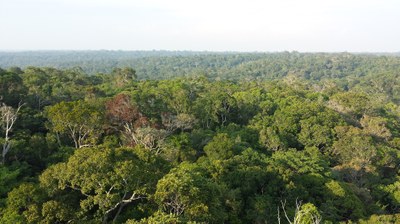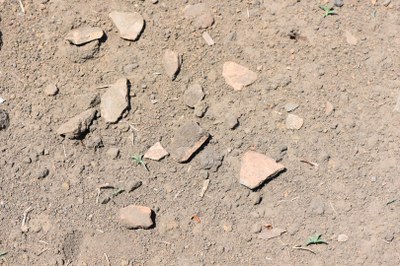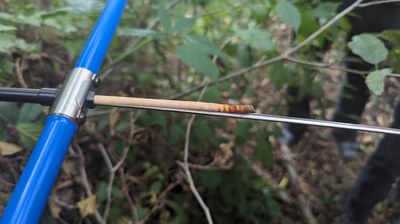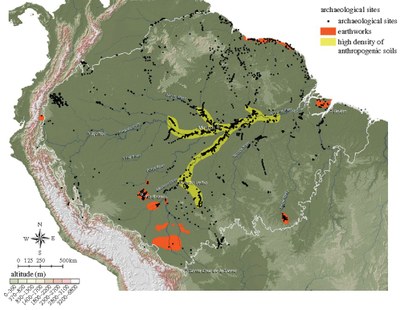Tracking global climate change in the Amazon
International Amazon expedition led by the University of Giessen – "Black Earth" as a carbon store and forensic methods to combat illegal logging in focus
No 124 • 22 August 2023 - Deutsche Version

Tropical forests are elementary for humankind. They play a decisive role in determining global climate and weather patterns and are crucial for biodiversity. This is particularly true for the Brazilian rainforest in the Amazon catchment area. In order to investigate important questions on global climate change, an international, interdisciplinary research team led by Prof. Dr. Christoph Müller, Institute of Plant Ecology at Justus Liebig University Giessen (JLU), will set off on a four-week expedition to the Brazilian rainforest on 26 August 2023.
From the city of Manaus in northwest Brazil, the eight-member research team will visit various study sites along the Amazon, covering a distance of over 700 kilometres on the Amazon. The research trip, which has been in preparation for years, has two goals: On the one hand, the so-called Terra preta soils will be explored, which have special carbon storage properties and are also very fertile. On the other hand, scientific forensic methods are to be developed to combat illegal logging - the latter at the request of the Brazilian government under President Lula, which wants to preserve the rainforest and protect it more strongly.
The research is being conducted in close cooperation with the Brazilian government and the EMBRAPA Agricultural Research Institute in Manaus, with which JLU has maintained close cooperation for many years. In addition, the International Atomic Energy Agency (IAEA) in Vienna is involved, which together with the Food and Agriculture Organisation (FAO) maintains a centre for issues of global food security and sustainable agriculture in Vienna.

Research focus Terra preta de Indio ("Black Earth")
The soil of the rainforest is generally poor and lacking in nutrients; unlike soils in temperate latitudes such as Central Europe, it does not have any humus formation worth mentioning. In some places, however, there are special soils in the Amazon rainforest called terra preta, "black earth". These soils are fertile in the long term even without fertilisation and can store several times more carbon than the usual soil in the rainforest. Terra preta is therefore of global scientific interest in two aspects: as a carbon store against the backdrop of climate change and for the development of resource-saving and climate-sensitive farming methods.
These are above all those forms of cultivation in which plants are used that can make best use of the soil's nutrients and resist drought stress.
During the expedition, studies on greenhouse gas fluxes (carbon dioxide, methane and nitrous oxide) will be carried out and soil samples will be taken to analyse the soil structure as well as carbon storage and microbial activity. "Our previous studies on greenhouse gas emissions of the Brazilian terra preta soil show that investigations under laboratory conditions do not yield valid results," says expedition leader Prof. Dr. Christoph Müller. "Therefore, it is necessary to do these specific investigations in the field.

Terra preta soils are man-made. They were created by charcoal and food waste, manure and compost. People who lived in the Amazon several thousand years ago and cultivated fields there added these materials to the soil over a long period of time. Among other things, pottery fragments in the Terra preta bear witness to their quite large settlements.
Although Terra preta soil is unique, there are also millennia of experience with coal and charcoal in Europe that are significant for the assessment of current research. For example, charcoal kilns were operated more than 2000 years ago by the Celts who settled in Central Europe at that time. Particularly in the Siegerland region, such former kiln soils exist, which are roughly comparable to Terra preta soils, although these were not used for agriculture, unlike the areas in the Amazon.
At JLU, Prof. Müller's team is trying to produce a kind of Terra preta. Since 2011, the scientists have been conducting a biochar experiment on an experimental plot at the Environmental Monitoring and Climate Impact Research Station in Linden-Leihgestern, in which plant charcoal made from Chinese reed was spread with pig manure. "Initial results show that the appropriately treated soil stores more carbon," says Prof. Müller. "Further research is needed to clarify questions of long-term storage capacity. Nevertheless, the so-called biochar application is currently the most effective method of removing carbon in the form of carbon dioxide from the atmosphere and storing it in a permanent form in the soil. This makes it an important piece of the mosaic in the fight against climate change."

Research focus illegal logging
The second research focus of the Amazon expedition deals with the question of how illegal logging can be combated more effectively with scientific support. Logging, which is often illegal and organised, is largely responsible for clearing large areas of rainforest. This increases the risk of reaching the tipping point in the loss of the Amazon rainforest – with fatal consequences for the global climate. So far, there is a particular lack of knowledge on how to identify illegal tropical timber, for example in timber warehouses in Germany. To do this, it is necessary to prove in a reliable and legally secure manner that this timber was illegally felled at a specific location.
Isotope analyses developed at JLU will be used to investigate whether the analytical methods that can be used for soils can also be transferred to trees (wood). During the expedition, samples of stem wood will be taken from the Terra preta sites visited and the wood cores will be documented. The long-term goal is to use the isotope analysis to create a tree cadastre that will enable the responsible international investigating authorities to allocate wood to be examined to the respective felling site. "It is a particular concern of ours that we bring together the scientific and forensic aspects for successfully combating illegal logging in a holistic approach and thus take it to a new level," Müller emphasises. At the wish of Brazil, follow-up research is to be carried out in Giessen, including by a Brazilian doctoral student from Manaus.
In addition to two scientists from the Institute of Plant Ecology and a JLU student, the eight-member Amazon expedition team includes two scientists from Brazil, a scientist from India and a charcoal maker and a criminalist from Germany.
- Contact
Prof. Dr. Christoph Müller
Institute of Plant Ecology
Phone: 0049 641 99-35300
E-Mail: CMueller
Presse, Kommunikation und Marketing • Justus-Liebig-Universität Gießen • Telefon: 0641 99-12041
